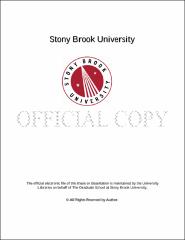| dc.identifier.uri | http://hdl.handle.net/11401/77787 | |
| dc.description.sponsorship | This work is sponsored by the Stony Brook University Graduate School in compliance with the requirements for completion of degree. | en_US |
| dc.format | Monograph | |
| dc.format.medium | Electronic Resource | en_US |
| dc.language.iso | en_US | |
| dc.publisher | The Graduate School, Stony Brook University: Stony Brook, NY. | |
| dc.type | Dissertation | |
| dcterms.abstract | Risk measurement and management are now seen in a global context. Accordingly, several new concepts and techniques have been proposed in the field of quantitative finance to address new types of risk such as systemic or systematic risk. In this dissertation, we present three topics related to risk measurement and management in global markets. We particularly focus on applications of tempered stable distributions to asset returns for the purpose of improving risk measurement and management. In the first part, we measure the systematic risk in global banking stock markets by using stocks of global systemically important financial institutions (G-SIFIs). Because G-SIFIs are identified by the financial regulator, measuring the G-SIFI risks is critical for assessment of the stability of the global financial system. For time series analysis, we adopt an autoregressive moving average (ARMA) generalized autoregressive conditional heteroscedasticity (GARCH) model with the multivariate normal tempered stable distributed innovations and demonstrate that it is a more realistic model to use with G-SIFI stocks. For measuring the risk, we take different approaches including CoVaR and its extension to average value at risk (AVaR), which we refer to as CoAVaR. We discuss the relationship among different risk measures. In the second part, we propose mean-CoAVaR portfolio optimization to mitigate the potential loss caused by systematic risk. This is a strategy to minimize the portfolio's CoAVaR with a given expected return. Through empirical studies of portfolios comprising G-SIFI stocks, we confirm that the mean-CoAVaR strategy is effective during a financial crisis. In the third part, we examine a time series of global currency exchange rates by using currencies circulating in the member countries of the Organization for Economic Co-operation and Development (OECD). We propose a better model to describe the dynamics of exchange rates, by comparing GARCH and Markov-switching models through both in-sample and out-of-sample tests. Also, the multivariate modeling for OECD currency exchange rates is discussed. We conclude that the tempered stable GARCH model is recommendable, especially for risk management purposes. | |
| dcterms.available | 2017-09-20T16:53:35Z | |
| dcterms.contributor | Li, Xiaolin | en_US |
| dcterms.contributor | Rachev, Svetlozar T | en_US |
| dcterms.contributor | Xing, Haipeng | en_US |
| dcterms.contributor | Smith, Noah. | en_US |
| dcterms.creator | Kurosaki, Tetsuo | |
| dcterms.dateAccepted | 2017-09-20T16:53:35Z | |
| dcterms.dateSubmitted | 2017-09-20T16:53:35Z | |
| dcterms.description | Department of Applied Mathematics and Statistics. | en_US |
| dcterms.extent | 131 pg. | en_US |
| dcterms.format | Monograph | |
| dcterms.format | Application/PDF | en_US |
| dcterms.identifier | http://hdl.handle.net/11401/77787 | |
| dcterms.issued | 2015-08-01 | |
| dcterms.language | en_US | |
| dcterms.provenance | Made available in DSpace on 2017-09-20T16:53:35Z (GMT). No. of bitstreams: 1
Kurosaki_grad.sunysb_0771E_11312.pdf: 1928052 bytes, checksum: a118834ce6a611c9c7eccedc468a2871 (MD5)
Previous issue date: 2013 | en |
| dcterms.publisher | The Graduate School, Stony Brook University: Stony Brook, NY. | |
| dcterms.subject | CoVaR, GARCH model, Markov switching model, Normal tempered stable distribution, Systemic risk | |
| dcterms.subject | Applied mathematics | |
| dcterms.title | Risk Measurement and Management in the Global Markets with the Tempered Stable Distributions | |
| dcterms.type | Dissertation | |

